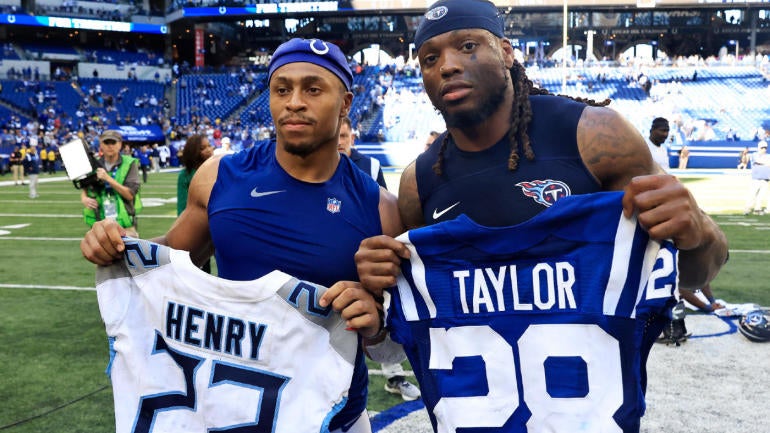
2023 has been a terrible year for veteran running backs. The number of running backs with contracts averaging $12 million per year or more has been cut in half thanks to releases and pay cuts. There were eight at the end of last season. Four remain.
NFL teams exercised fiscal restraint with running backs in free agency this year. Nobody hit the $7 million per mark, which represents the top of the second salary tier for running back compensation, with a deal like what James Conner and Leonard Fournette did in 2022 free agency.
The three running backs designated as franchise players (Saquon Barkley, Josh Jacobs and Tony Pollard) didn't sign multi-year contracts before the July 17 deadline to sign long term. Barkley and Jacobs are facing the prospect for playing the 2023 season for $10.091 million should they sign their franchise tender, which Pollard did back in March. Long-term deals are prohibited from being signed until the 2023 regular season ends on January 7, 2024.
Several high profile running backs, including Christian McCaffrey, Austin Ekeler, Derrick Henry and Jonathan Taylor, expressed their frustration about the plight of running backs on social media right after Barkley and Jacobs didn't get deals from the Giants and Raiders, respectively. McCaffrey called the situation "criminal" on Twitter.
The Panthers made McCaffrey the NFL's highest paid running back in 2020 on a four-year contract extension averaging $16,015,853 per year with $39,162,500 of guarantees. McCaffrey has a running back best $30,062,500 fully guaranteed at signing.
Best shot to stop the worrisome trend
The best chance for a running back to stem the tide is Taylor. The 2020 second round pick in is a contract year. The Colts have a track record of extending the contracts of core players in the final year of rookie deals. Taylor is scheduled to make $4.304 million this season on a $5,117,482 salary cap number.
The circumstances are less than ideal for Taylor. Recent developments in the running back market have stacked the deck against him. Taylor coming off a career low 861 rushing yards in 11 games behind an inconsistent offensive line while being slowed by a right ankle injury, which required offseason surgery, also complicates matters. His 2022 performance is in stark contrast to a stellar 2021 season in which Taylor was easily the league's best running back.
Taylor led the NFL with 2,171 yards from scrimmage, 1,811 rushing yards, 20 total touchdowns and 18 rushing touchdowns in 2021. He won the rushing title by 552 yards while averaging 5.5 yards per carry. Since entering the NFL in 2020, Taylor ranks third in yards from scrimmage (4,643), fourth in rushing yards (3,841) and fourth in touchdowns (36).
The Colts are set up to accommodate a lucrative running back contract. Since Anthony Richardson was taken with the fourth overall pick in this year's NFL Draft, there shouldn't be a high-priced quarterback on the roster for the foreseeable future. Once Richardson signs his rookie contract, his 2023, 2024, 2025 and 2026 cap numbers are expected to be $6,180,733, $7,725,916, $9,271,099 and $10,816,282. The Colts will also have an option for a 5th year in 2027 where the decision on the extra year has to be made after Richardson's third season.
Richardson's contract can't be extended until 2026. By the time a major financial commitment would need to be made to Richardson if he is living up to his draft position, Taylor would be in the latter stages of his contract or it would be on the verge of expiring.
Richardson is also extremely inexperienced, having only started 13 games in college at the University of Florida. The strong rushing attack Taylor should be able to provide would take pressure off Richardson as he adapts to the NFL and develops as a quarterback.
Teammates Quenton Nelson and Shaquille Leonard reset the offensive guard and off-ball linebacker markets last year and in 2021, respectively. The Colts surely won't do the same for Taylor, although he is just 24, given his 2022 season.
Due for a reset: Chubb last big payday
The running back market is due for a reset. It's the only positional market that hasn't increased since McCaffrey signed more than three years is running back.
The last running back to get a big payday was Nick Chubb in 2021 when he was going into the final year of his rookie contract. The Browns gave Chubb a three-year, $36.6 million contract extension averaging $12.2 million per year. The deal had $20 million in overall guarantees where $17,133,059 was fully guaranteed.
Barkley reportedly rejected a three-year offer in the $11 million per year neighborhood with $22 million to $23 million in guarantees at the July 17 deadline. These numbers were apparently within $1 million to $2 million of what Barkley was looking for to consummate a deal. The average yearly salary the Giants offered was approximately the average of Barkley playing on consecutive franchise tags in 2023 and 2024. The guarantees are essentially the total of Barkley playing under the franchise tag for two straight years.
It wouldn't be a surprise for the Colts to take a similar approach as the Giants did with Barkley by using the projected 2024 franchise tag as a guide in any negotiations for a Taylor contract extension. Taylor would be a prime candidate for a franchise tag next offseason with a bounce-back year.
The non-exclusive franchise tag for running backs next year projects to 4.653% of 2024 salary cap. Assuming the 2024 salary cap is set in the $250 million neighborhood, this number would be right around $11.625 million. A second franchise tag in 2025 with a NFL Collective Bargaining Agreement mandated 20% raise would be approximately $14 million.
The average of two projected franchise tags suggests the Colts should be comfortable giving Taylor a three year or four year extension averaging $12.75 million per year. Total guarantees should be $25.5 million.
What to expect for Henry, Barkley, Jacobs
Coincidentally, $25.5 million is the amount that was fully guaranteed when Henry signed a four-year deal averaging $12.5 million (worth a maximum of $51 million through incentives) in 2020 after being designated as a franchise player by the Titans for $10.278 million. The deal wasn't constrained by the value of two straight franchise tags.
The $25.5 million fully guaranteed was 12.77% more than going year-to-year on tags. Henry's $12.5 million average yearly salary represented 10.56% over the average of being franchised twice in a row. Taylor advocating for Henry treatment would mean a four year extension where close to $29 million is fully guaranteed with the deal averaging approximately $14.125 million per year.
Henry has an expiring contract, like Taylor. It will be too cost prohibitive to place a franchise tag on him next year because he would be getting a 120% increase over his prior year's salary (essentially the salary cap number with some minor adjustments). Henry has 2023's largest running back cap number at $16,367,647. With the way the 120% salary increase provisions work for the designation, Henry's 2024 franchise tag would be slightly under $19.5 million.
Henry has led the NFL in rushing attempts in three of the last four seasons. He'll have over 2,000 career carries with his typical workload this season. As a 30-year-old free agent in 2024, Henry will likely be hard pressed to get deal comparable to his current $12.5 million per year contract because of the anticipated diminishing returns given his high mileage.
Barkley and Jacobs are expected to be absent when the Giants and Raiders veterans report to training camp on July 25. Odds are both will sign the $10.091 million franchise tender at some point before the regular season starts for their respective teams on Sept. 10. A Pro Bowl caliber season would bring a second franchise tag for $12,109,200, a 20% increase of the current designation, into play.
The future: A different approach for RB contracts
The unique set of challenges encountering running backs trying to get paid at the highest level may force agents to start taking a different approach than when representing players at other positions. Ordinarily, a player will reap the benefits of a career year when his contract is expiring once he hits free agency.
That certainly wasn't the case with Miles Sanders this year. Sanders had career highs of 1,269 rushing yards and 11 rushing touchdowns, which were fifth and eight in the NFL respectively, with the Eagles last season. He got a four-year, $25.64 million deal averaging $6.35 million per year from the Panthers with $13 million fully guaranteed.
As a highly productive No. 1 wide receiver just completing his rookie contract, Sanders likely would have commanded a contract in excess of $20 million per year. Mike Williams, who was co-No. 1 wide receiver at best with the Chargers, signed a three-year, $60 million contract containing $40 million fully guaranteed to remain in Los Angeles last year.
The eight running backs that had deals averaging $12 million per year or more at the end of last season were all re-signed by their own team. Getting an extension before the expiration of a contract should be the top priority.
Seasoned agents avoid signing backloaded contracts. In a backloaded deal, there's more money in the latter years than in the early years. The savvier agents typically aren't happy with flat contracts where the cash after each year equals the average of the deal. The goal is to frontload a contract where there's more money in the early years than in back half of the deal while at least the first two years are fully guaranteed at signing.
These traditional conventions about structuring contracts might have to be put aside when dealing with a running back, given the current financial climate with the position. The flat contract that ordinarily would have been dismissed could get more consideration as an acceptable structure for a running back.
Performance bonuses, incentives and salary escalators are used to bridge the gap when there is a disagreement in a negotiation between a player's agent and the team on the player's value. Incentives are frequently in one-year "prove it" deals for players who performed poorly or suffered an injury in a contract year where the market for a satisfactory long-term deal doesn't develop. Agents trying to build considerable "upside" into multi-year running back contracts might start happening more frequently, especially as long as the top of the market remains stagnant.





















